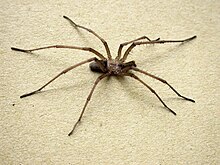You are here
Taxonomy
Filistatidae Simon, 1864
EOL Text
The spider family Filistatidae (crevice weavers) includes 115 described species (Platnick 2013). Seven of these species occur in North America north of Mexico, including five large spiders in the genus Kukulcania (the other two are small spiders, <5 mm long) (Bradley 2013).
The common name "crevice weaver" refers to the retreat these spiders build in a crack or similar space, usually among rocks or dead wood. The spider builds a silken tube in this space then extends a circular band of hackle-banded silk (i.e., silk from the cribellum) in a circular pattern around the entrance. From this circular area the spider spins a series of long trip lines, yielding a distinctive web. Crevice weavers can often be found in and around buildings. (Bradley 2013).
The synanthropic Southern House Spider (Kukulcania hibernalis) is found in the southeastern United States (Bradley 2013), but is also widespread in South America (Brescovit and Santos 2013). It is among the most common spiders within its range in the eastern United States (Howell and Jenkins 2004). The eight eyes are tightly grouped on a central mound (Bradley 2013). This spider exhibits conspicuous sexual dimorphism. The female is dusky gray or black with a velvety covering of hairs. The legs have velvet hairs and many short spines. The male is tan with long legs and palps. These palps are often held in a folded position position, extending directly in front of the chelicerae. Markings on the male's carapace (the upper part of the cephalothorax) often result in these spiders being misidentified as Brown Recluse Spiders (Loxosceles reclusa), although Brown Recluses can be easily distinguished from Southern House Spiders by the fact that they have six eyes rather than eight eyes (Howell and Jenkins 2004; Gaddy 2009). Although the female Southern House Spider stays around her web crevice, the male roams and hunts like a wolf spider or fishing spider (Gaddy 2009).
| License | http://creativecommons.org/licenses/by/3.0/ |
| Rights holder/Author | Leo Shapiro, Leo Shapiro |
| Source | No source database. |
FilistatidaeAnimalia
Filistatidae Ausserer, 1867
| License | Public Domain |
| Rights holder/Author | No known copyright restrictions apply. See Agosti, D., Egloff, W., 2009. Taxonomic information exchange and copyright: the Plazi approach. BMC Research Notes 2009, 2:53 for further explanation. |
| Source | http://treatment.plazi.org/id/60A1A55C09507FDF2FA05DFEE3C1871C |
FilistatidaeAnimalia
Filistatidae Ausserer, 1867
| License | Public Domain |
| Rights holder/Author | No known copyright restrictions apply. See Agosti, D., Egloff, W., 2009. Taxonomic information exchange and copyright: the Plazi approach. BMC Research Notes 2009, 2:53 for further explanation. |
| Source | http://treatment.plazi.org/id/F20D5CC4B0FEEFDCC98CD9078C7C37A2 |
Barcode of Life Data Systems (BOLD) Stats
Specimen Records:128
Specimens with Sequences:41
Specimens with Barcodes:40
Species:33
Species With Barcodes:3
Public Records:4
Public Species:1
Public BINs:1
The crevice weaver spiders (super-family Filistatoidea, family Filistatidae) contain primitive cribellate spiders. They are haplogyne weavers of funnel or tube webs. The family contains 17 genera and more than hundred described species worldwide. One of the most abundant members of this family in the Americas is the Southern house spider (Kukulcania hibernalis). Named after the fierce Meso-American god Kukulkan, the females are large (up to nearly 20 mm) dark-colored spiders and males are light brown, smaller (about 10 mm.), but more long-legged and with palpi that are held together in front of their carapaces like the horn of a unicorn. The males also have a darker streak on the center of the dorsal carapace that causes them to be often mistaken for brown recluse spiders. The tiny members of the genus Filistatinella are like miniature versions of Kukulcania. The nominate genus Filistata is Afro-Eurasian in distribution. In many older books the species from the Americas now placed in the genus Kukulcania are placed in Filistata.
A striking visual characteristic of the family, beside dimorphism, is the unusual upward bend encountered near the femur of the first pair of legs. While resembling hydraulic muscle mechanisms akin to arthropods, this modification actually allows the spider to retain the prey directly from the crevice it occupies. Also, if the larger prey ever tries to pull it from the crevice, the spider can use these legs to "grab" to the side walls and hence make it difficult. Many Kukulcania species also use them to dig holes in the soft ground at 25-30 degree angle.
Genera[edit]
The categorization into subfamilies follows Joel Hallan's Biology Catalog.
- Filistatinae Ausserer, 1867
- Filistata Latreille, 1810 (Mediterranean, Asia, Mexico)
- Kukulcania Lehtinen, 1967 (America)
- Sahastata Benoit, 1968 (Mediterranean to India)
- Zaitunia Lehtinen, 1967 (Iran, Israel, Tajikistan, Uzbekistan)
- Prithinae Gray, 1995
- Afrofilistata Benoit, 1968 (Africa)
- Andoharano Lehtinen, 1967 (Madagascar)
- Filistatinella Gertsch & Ivie, 1936 (USA)
- Filistatoides O. P-Cambridge, 1899 (Guatemala, Cuba, Chile)
- Lihuelistata Ramírez & Grismado, 1997 (Argentina)
- Misionella Ramírez & Grismado, 1997 (Brazil, Argentina)
- Pikelinia Mello-Leitão, 1946 (Argentina, Colombia, Galapagos)
- Pritha Lehtinen, 1967 (Asia, Mediterranean, New Guinea)
- Wandella Gray, 1994 (Australia)
- Yardiella Gray, 1994 (Australia)
- incertae sedis
- Microfilistata Zonstein, 1990 (Tajikistan)
- Tricalamus Wang, 1987 (China)
See also[edit]
| License | http://creativecommons.org/licenses/by-sa/3.0/ |
| Rights holder/Author | Wikipedia |
| Source | http://en.wikipedia.org/w/index.php?title=Crevice_weaver&oldid=580129754 |



